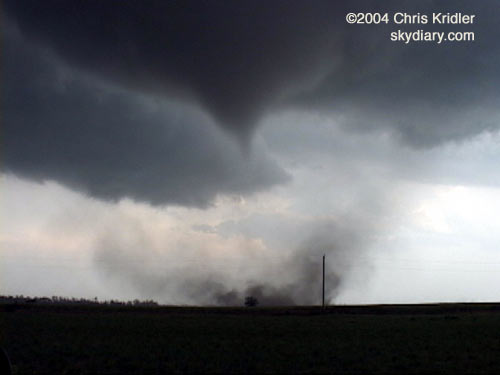You know, I really thought this would be one year when I wouldn’t have to cut my storm-chase trip to Tornado Alley short because of my schedule and miss some big event. I thought I’d be chasing by the first week of May and could even go a couple of weeks into June if the pattern remained stupendous. Only it’s stupendous in a totally different way. After really early season events that I couldn’t chase because of other commitments, the pattern has afforded very few storms this month, and I’m still in Florida, playing the waiting game. Chances are, the action could pick up again at the end of this month, or in June, but I have to be back in Florida mid-June for, yes, obligations. Because I just can’t block off two or three months for chasing storms at this point in my life.

Tornado destroys a house in Attica, Kansas, on May 12, 2004. Photo (c) Chris Kridler, ChrisKridler.com, SkyDiary.com
May 12 is what my chaser friends call “the anniversary.” For a small group of us, it marks the anniversary of two big events – the May 12, 2004, Attica, Kansas, tornadoes, one of which destroyed a house less than a half-mile away from us, and the May 12, 2005, tornado and hail barrage near South Plains, Texas. I’ve been pulling choice video from my archive and posting it to my YouTube channel. Today, I’m posting a 10-minute, raw-video cut of the Attica, Kansas, tornadoes. Dave Lewison was in my car, and Pete Ventre was driving Scott McPartland in Scott’s car. The video is amusing for its stressed-out dialogue as we try to avoid baseball-size hail, maintain position without getting too close, and narrowly miss two satellite tornadoes that briefly blocked our escape route. There’s also a sighting of the early TIV, Sean Casey’s Tornado Intercept Vehicle.
Meanwhile … it’s pretty quiet. I’ve done almost all the tinkering my chase gear requires. I’m working on the sequel to my novel “Funnel Vision,” which at least affords the excitement of fictional storm chasing. But it’s May. We should be experiencing the real thing.





















